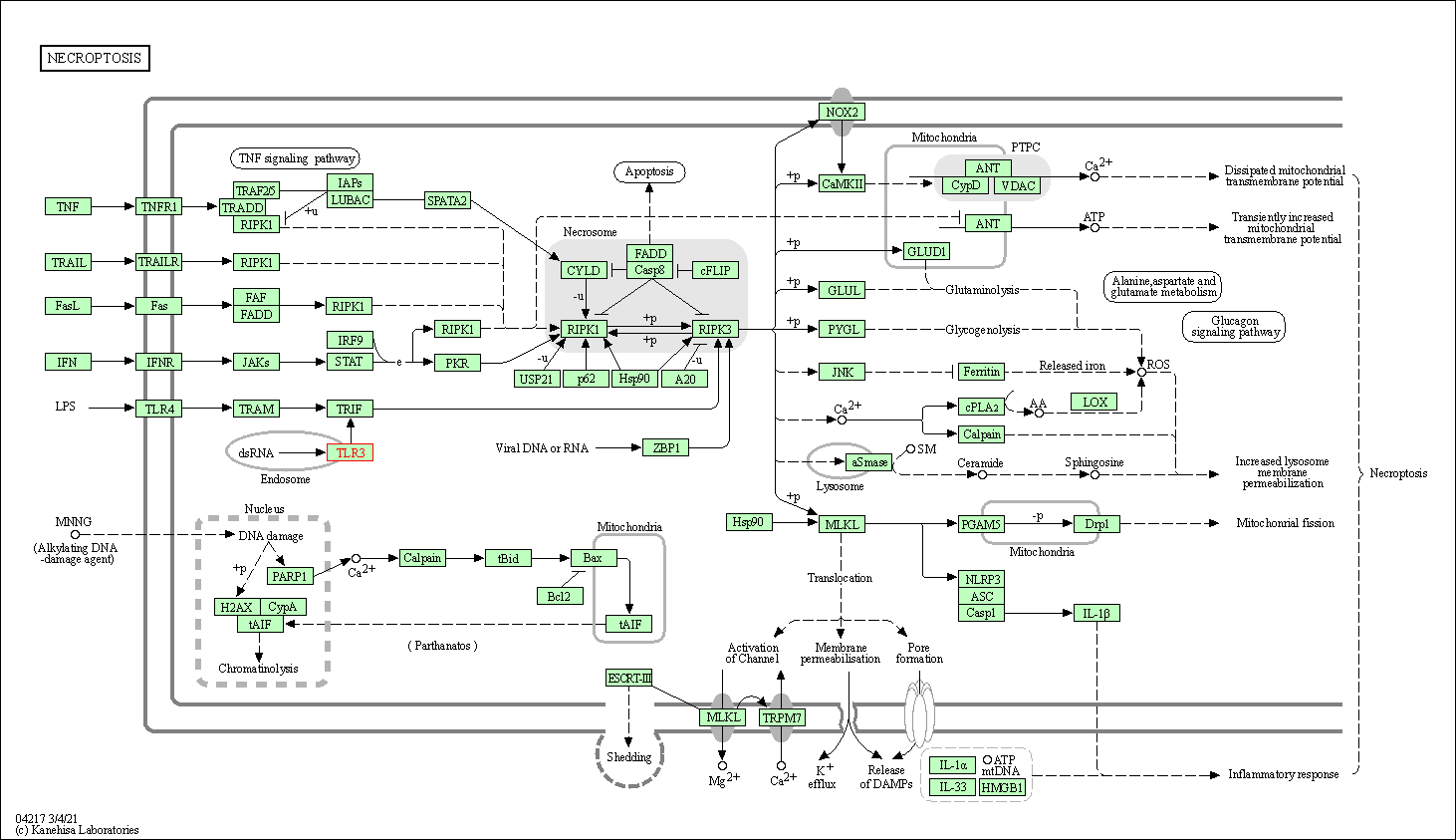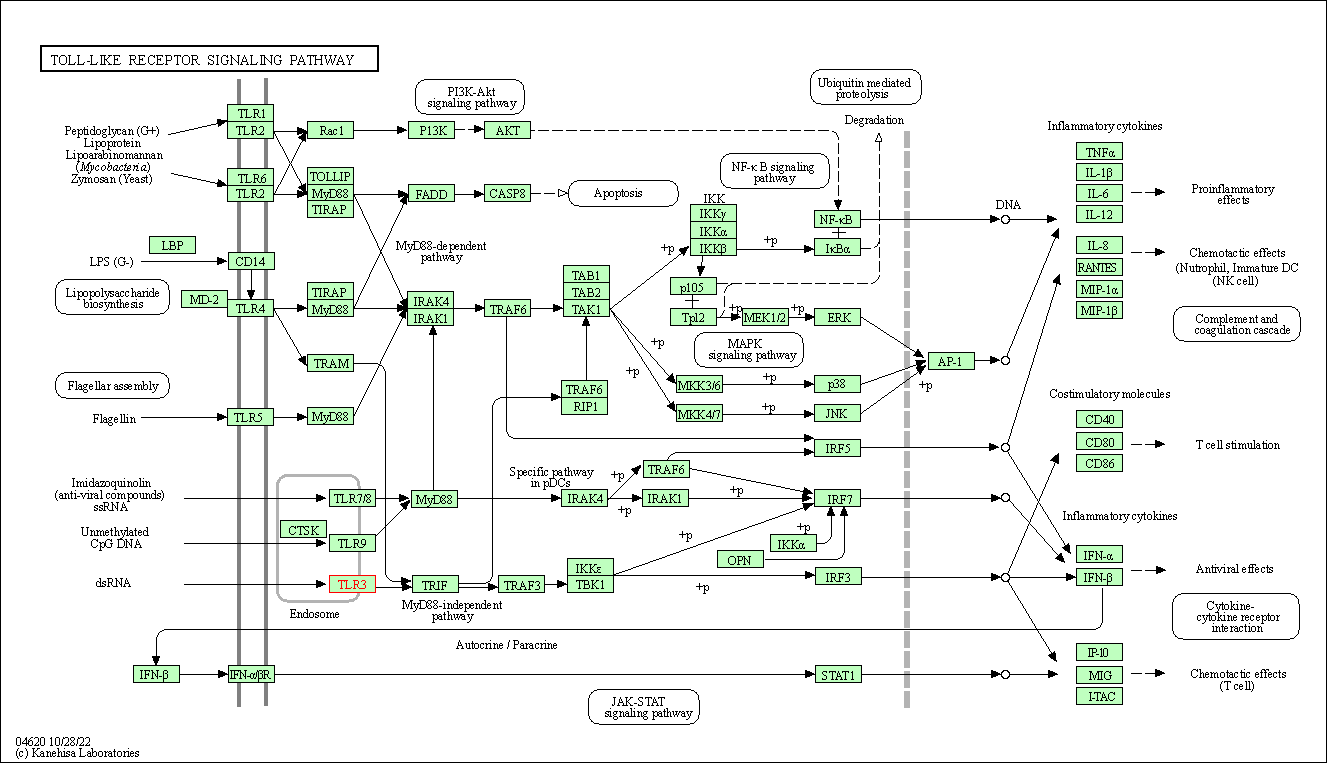Target Information
| Target General Information | Top | |||||
|---|---|---|---|---|---|---|
| Target ID |
T99834
|
|||||
| Target Name |
HUMAN toll-like receptor 3 (TLR3)
|
|||||
| Synonyms |
CD283
Click to Show/Hide
|
|||||
| Gene Name |
TLR3
|
|||||
| Disease | [+] 1 Target-related Diseases | + | ||||
| 1 | Postviral fatigue syndrome [ICD-11: 8E49] | |||||
| Function |
Key component of innate and adaptive immunity. TLRs (Toll-like receptors) control host immune response against pathogens through recognition of molecular patterns specific to microorganisms. TLR3 is a nucleotide-sensing TLR which is activated by double-stranded RNA, a sign of viral infection. Acts via the adapter TRIF/TICAM1, leading to NF-kappa-B activation, IRF3 nuclear translocation, cytokine secretion and the inflammatory response.
Click to Show/Hide
|
|||||
| BioChemical Class |
Toll-like receptor
|
|||||
| UniProt ID | ||||||
| Sequence |
MRQTLPCIYFWGGLLPFGMLCASSTTKCTVSHEVADCSHLKLTQVPDDLPTNITVLNLTH
NQLRRLPAANFTRYSQLTSLDVGFNTISKLEPELCQKLPMLKVLNLQHNELSQLSDKTFA FCTNLTELHLMSNSIQKIKNNPFVKQKNLITLDLSHNGLSSTKLGTQVQLENLQELLLSN NKIQALKSEELDIFANSSLKKLELSSNQIKEFSPGCFHAIGRLFGLFLNNVQLGPSLTEK LCLELANTSIRNLSLSNSQLSTTSNTTFLGLKWTNLTMLDLSYNNLNVVGNDSFAWLPQL EYFFLEYNNIQHLFSHSLHGLFNVRYLNLKRSFTKQSISLASLPKIDDFSFQWLKCLEHL NMEDNDIPGIKSNMFTGLINLKYLSLSNSFTSLRTLTNETFVSLAHSPLHILNLTKNKIS KIESDAFSWLGHLEVLDLGLNEIGQELTGQEWRGLENIFEIYLSYNKYLQLTRNSFALVP SLQRLMLRRVALKNVDSSPSPFQPLRNLTILDLSNNNIANINDDMLEGLEKLEILDLQHN NLARLWKHANPGGPIYFLKGLSHLHILNLESNGFDEIPVEVFKDLFELKIIDLGLNNLNT LPASVFNNQVSLKSLNLQKNLITSVEKKVFGPAFRNLTELDMRFNPFDCTCESIAWFVNW INETHTNIPELSSHYLCNTPPHYHGFPVRLFDTSSCKDSAPFELFFMINTSILLIFIFIV LLIHFEGWRISFYWNVSVHRVLGFKEIDRQTEQFEYAAYIIHAYKDKDWVWEHFSSMEKE DQSLKFCLEERDFEAGVFELEAIVNSIKRSRKIIFVITHHLLKDPLCKRFKVHHAVQQAI EQNLDSIILVFLEEIPDYKLNHALCLRRGMFKSHCILNWPVQKERIGAFRHKLQVALGSK NSVH Click to Show/Hide
|
|||||
| 3D Structure | Click to Show 3D Structure of This Target | PDB | ||||
| Drugs and Modes of Action | Top | |||||
|---|---|---|---|---|---|---|
| Drugs in Phase 1 Trial | [+] 1 | + | ||||
| 1 | Rintatolimod | Drug Info | phase 3 | Chronic fatigue syndrome | [2] | |
| Mode of Action | [+] 1 Modes of Action | + | ||||
| Agonist | [+] 2 Agonist drugs | + | ||||
| 1 | Rintatolimod | Drug Info | [3], [4] | |||
| 2 | Polyinosinic:polycytidylic acid | Drug Info | [5] | |||
| Cell-based Target Expression Variations | Top | |||||
|---|---|---|---|---|---|---|
| Cell-based Target Expression Variations | ||||||
| Drug Binding Sites of Target | Top | |||||
|---|---|---|---|---|---|---|
| Ligand Name: (2S,3R,4S,5S,6R)-6-(hydroxymethyl)oxane-2,3,4,5-tetrol | Ligand Info | |||||
| Structure Description | The molecular structure of toll-like receptor 3 ligand binding domain | PDB:2A0Z | ||||
| Method | X-ray diffraction | Resolution | 2.40 Å | Mutation | No | [6] |
| PDB Sequence |
TKCTVSHEVA
35 DCSHLKLTQV45 PDDLPTNITV55 LNLTHNQLRR65 LPAANFTRYS75 QLTSLDVGFN 85 TISKLEPELC95 QKLPMLKVLN105 LQHNELSQLS115 DKTFAFCTNL125 TELHLMSNSI 135 QKIKNNPFVK145 QKNLITLDLS155 HNGLSSTKLG165 TQVQLENLQE175 LLLSNNKIQA 185 LKSEELDIFA195 NSSLKKLELS205 SNQIKEFSPG215 CFHAIGRLFG225 LFLNNVQLGP 235 SLTEKLCLEL245 ANTSIRNLSL255 SNSQLSTTSN265 TTFLGLKWTN275 LTMLDLSYNN 285 LNVVGNDSFA295 WLPQLEYFFL305 EYNNIQHLFS315 HSLHGLFNVR325 YLNLKRSFTK 335 QSISLASLPK345 IDDFSFQWLK355 CLEHLNMEDN365 DIPGIKSNMF375 TGLINLKYLS 385 LSNSFTSLRT395 LTNETFVSLA405 HSPLHILNLT415 KNKISKIESD425 AFSWLGHLEV 435 LDLGLNEIGQ445 ELTGQEWRGL455 ENIFEIYLSY465 NKYLQLTRNS475 FALVPSLQRL 485 MLRRVALKNV495 DSSPSPFQPL505 RNLTILDLSN515 NNIANINDDM525 LEGLEKLEIL 535 DLQHNNLARL545 WKHANPGGPI555 YFLKGLSHLH565 ILNLESNGFD575 EIPVEVFKDL 585 FELKIIDLGL595 NNLNTLPASV605 FNNQVSLKSL615 NLQKNLITSV625 EKKVFGPAFR 635 NLTELDMRFN645 PFDCTCESIA655 WFVNWINETH665 TNIPELSSHY675 LCNTPPHYHG 685 FPVRLFDTSS695 C
|
|||||
|
|
||||||
| Click to View More Binding Site Information of This Target with Different Ligands | ||||||
| Different Human System Profiles of Target | Top |
|---|---|
|
Human Similarity Proteins
of target is determined by comparing the sequence similarity of all human proteins with the target based on BLAST. The similarity proteins for a target are defined as the proteins with E-value < 0.005 and outside the protein families of the target.
A target that has fewer human similarity proteins outside its family is commonly regarded to possess a greater capacity to avoid undesired interactions and thus increase the possibility of finding successful drugs
(Brief Bioinform, 21: 649-662, 2020).
Human Tissue Distribution
of target is determined from a proteomics study that quantified more than 12,000 genes across 32 normal human tissues. Tissue Specificity (TS) score was used to define the enrichment of target across tissues.
The distribution of targets among different tissues or organs need to be taken into consideration when assessing the target druggability, as it is generally accepted that the wider the target distribution, the greater the concern over potential adverse effects
(Nat Rev Drug Discov, 20: 64-81, 2021).
Human Pathway Affiliation
of target is determined by the life-essential pathways provided on KEGG database. The target-affiliated pathways were defined based on the following two criteria (a) the pathways of the studied target should be life-essential for both healthy individuals and patients, and (b) the studied target should occupy an upstream position in the pathways and therefore had the ability to regulate biological function.
Targets involved in a fewer pathways have greater likelihood to be successfully developed, while those associated with more human pathways increase the chance of undesirable interferences with other human processes
(Pharmacol Rev, 58: 259-279, 2006).
Biological Network Descriptors
of target is determined based on a human protein-protein interactions (PPI) network consisting of 9,309 proteins and 52,713 PPIs, which were with a high confidence score of ≥ 0.95 collected from STRING database.
The network properties of targets based on protein-protein interactions (PPIs) have been widely adopted for the assessment of target’s druggability. Proteins with high node degree tend to have a high impact on network function through multiple interactions, while proteins with high betweenness centrality are regarded to be central for communication in interaction networks and regulate the flow of signaling information
(Front Pharmacol, 9, 1245, 2018;
Curr Opin Struct Biol. 44:134-142, 2017).
Human Similarity Proteins
Human Tissue Distribution
Human Pathway Affiliation
Biological Network Descriptors
|
|
|
Note:
If a protein has TS (tissue specficity) scores at least in one tissue >= 2.5, this protein is called tissue-enriched (including tissue-enriched-but-not-specific and tissue-specific). In the plots, the vertical lines are at thresholds 2.5 and 4.
|
| KEGG Pathway | Pathway ID | Affiliated Target | Pathway Map |
|---|---|---|---|
| Necroptosis | hsa04217 | Affiliated Target |

|
| Class: Cellular Processes => Cell growth and death | Pathway Hierarchy | ||
| Toll-like receptor signaling pathway | hsa04620 | Affiliated Target |

|
| Class: Organismal Systems => Immune system | Pathway Hierarchy | ||
| Degree | 12 | Degree centrality | 1.29E-03 | Betweenness centrality | 1.43E-04 |
|---|---|---|---|---|---|
| Closeness centrality | 2.22E-01 | Radiality | 1.39E+01 | Clustering coefficient | 4.39E-01 |
| Neighborhood connectivity | 3.98E+01 | Topological coefficient | 1.72E-01 | Eccentricity | 12 |
| Download | Click to Download the Full PPI Network of This Target | ||||
| Chemical Structure based Activity Landscape of Target | Top |
|---|---|
| References | Top | |||||
|---|---|---|---|---|---|---|
| REF 1 | Coronaviruses - drug discovery and therapeutic options. Nat Rev Drug Discov. 2016 May;15(5):327-47. | |||||
| REF 2 | ClinicalTrials.gov (NCT00215813) Ampligen in Chronic Fatigue Syndrome. U.S. National Institutes of Health. | |||||
| REF 3 | Efficacy of rintatolimod in the treatment of chronic fatigue syndrome/myalgic encephalomyelitis (CFS/ME). Expert Rev Clin Pharmacol. 2016 Jun;9(6):755-70. | |||||
| REF 4 | AIM ImmunoTech Announces FDA Authorization for First Human Ampligen Trial in COVID-19 Patients with Cancer; Provides Corporate Business Update for the First Quarter of 2020 | |||||
| REF 5 | Middle East Respiratory Syndrome Coronavirus (MERS-CoV): Infection, Immunological Response, and Vaccine Development. J Immunol Res. 2019 Apr 7;2019:6491738. doi: 10.1155/2019/6491738. | |||||
| REF 6 | The molecular structure of the Toll-like receptor 3 ligand-binding domain. Proc Natl Acad Sci U S A. 2005 Aug 2;102(31):10976-80. | |||||
If You Find Any Error in Data or Bug in Web Service, Please Kindly Report It to Dr. Zhou and Dr. Zhang.

